Monthly Updates on Recent Books in the History of Christianity
To raise awareness of recent books in the history of Christianity, the editorial staff of Church History: Studies in Christianity and Culture highlights each month a list of 10-15 books in diverse periods and geographical regions that we hope will be of interest to our members. We include here below the 28th monthly list, chosen by our staff, with excerpts from the publishers’ blurbs.
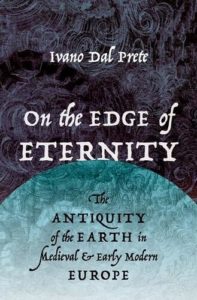
Ivano Dal Prete, On the Edge of Eternity: The Antiquity of the Earth in Medieval and Early Modern Europe. 2022
It is commonly assumed that the creation story of Genesis and its chronology were the only narratives openly available in medieval and early modern Europe and that the discovery of geological time in the eighteenth century came as a momentous breakthrough that shook the faith in the historical accuracy of the Bible. Historians of science, mainstream geologists, and Young Earth creationists alike all share the assumption that the notion of an ancient Earth was highly heterodox in the pre-modern era. The old age of the world is regarded as the offspring of a secularized science.
In this book, Ivano Dal Prete radically revises the commonplace history of deep time in Western culture. He argues that the chronology of the Bible always coexisted with alternative approaches that placed the origin of the Earth into a far, undetermined (or even eternal) past. From the late Middle Ages, these notions spread freely not only in universities and among the learned, but even in popular works of meteorology, geology, literature, and art that made them easily accessible to a vernacular and scientifically illiterate public. Religious authorities did not regard these notions as particularly problematic, let alone heretical. Neither the authors nor their numerous readers thought that holding such views was incompatible with their Christian faith. While the appeal of theories centered on the biblical Flood and on a young Earth gained popularity over the course of the seventeenth century, their more secular alternatives remained vital and debated. Enlightenment thinkers, however, created a myth of a Christian tradition that uniformly rejected the antiquity of the world, as opposed to a new secular science ready to welcome it. Largely unchallenged for almost three centuries, that account solidified over time into a still dominant truism.
Based on a wealth of mostly unexplored sources, On the Edge of Eternity offers an original and nuanced account of the history of deep time that illuminates the relationship between the history of science and Christianity in the medieval and early modern periods, with lasting implications for Western society.
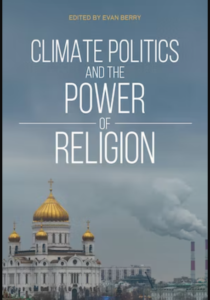
Evan Berry, ed. Climate Politics and the Power of Religion. 2022
Climate Politics and the Power of Religion is an edited collection that explores the diverse ways that religion shapes climate politics at the local, national, and international levels. Drawing on case studies from across the globe, it stands at the intersection of religious studies, environment policy, and global politics.
From small island nations confronting sea-level rise and intensifying tropical storms to high-elevation communities in the Andes and Himalayas wrestling with accelerating glacial melt, there is tremendous variation in the ways that societies draw on religion to understand and contend with climate change.
Climate Politics and the Power of Religion offers 10 timely case studies that demonstrate how different communities render climate change within their own moral vocabularies and how such moral claims find purchase in activism and public debates about climate policy. Whether it be Hindutva policymakers in India, curanderos in Peru, or working-class people's concerns about the transgressions of petroleum extraction in Trinidad―religion affects how they all are making sense of and responding to this escalating global catastrophe.
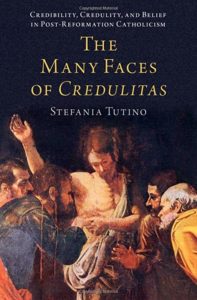
Stefania Tutino, The Many Faces of Credulitas: Credibility, Credulity, and Belief in Post-Reformation Catholicism. 2022
This book is about the relationship between belief, credibility, and credulity in post-Reformation Catholicism. It argues that, starting from the end of the sixteenth century and due to different political, intellectual, cultural, and theological factors, credibility assumed a central role in post-Reformation Catholic discourse. This led to an important reconsideration of the relationship between natural reason and supernatural grace and consequently to novel and significant epistemological and moral tensions. From the perspective of the relationship between credulity, credibility, and belief, early modern Catholicism emerges not as the apex of dogmatism and intellectual repression, but rather as an engine for promoting the importance of intellectual judgment in the process of embracing faith. To be sure, finding a balance between conscience and authority was not easy for early modern Catholics.
This book seeks to elucidate some of the difficulties, anxieties, and tensions caused by the novel insistence on credibility that came to dominate the theological and intellectual landscape of the early modern Catholic Church. In addition to shedding light on early modern Catholic culture, this book helps us to understand better what it means to believe. For the most part, in modern Western society we don't believe in the same things as our early modern predecessors. Even when we do believe in the same things, it is not in the same way. But believe we do, and thus understanding how early modern people addressed the question of belief might be useful as we grapple with the tension between credibility, credulity, and belief.
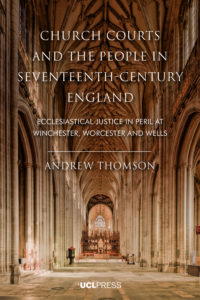
Andrew Thomson, Church Courts and the People in Seventeenth-Century England: Ecclesiastical justice in peril at Winchester, Worcester and Wells. 2022
University College London Press
Religion meant far more in early modern England than church on Sundays, a baptism, a funeral, or a wedding ceremony. The Church was fully enmeshed in the everyday lives of the people, their morals, and religious observance. It imposed comprehensive regulations on its flock focused on such issues as sex before marriage, adultery, and receiving the sacrament, and it employed an army of informers and bureaucrats, headed by a diocesan chancellor, to enable its courts to enforce the rules. Church courts lay, thus, at the very intersection of Church and people. This book offers a detailed survey of three dioceses across the whole of the century, examining key aspects such as attendance at court, completion of business, and, crucially, the scale of guilt to test the performance of the courts. For students and researchers of the seventeenth century, it provides a full account of court operations, measuring the extent of control, challenging orthodoxies about ex-communication, penance, and juries, contextualizing ecclesiastical justice within major societal issues of the times, and, ultimately, presents powerful evidence for a “church in danger” by the end of the century.
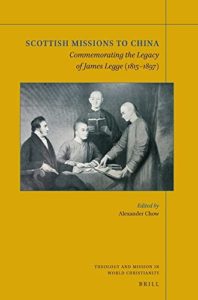
Alexander Chow, ed. Scottish Missions to China: Commemorating the Legacy of James Legge(1815-1897). 2022
This volume explores the important legacy of Scottish missions to China, with a focus on the missionary-scholar and Protestant sinologist par excellence James Legge (1815–1897). It challenges the simplistic caricature of Protestant missionaries as Orientalizing imperialists, but also shows how the Chinese context and Chinese persons “converted” Scottish missionaries in their understandings of China and the broader world.
Scottish Missions to China brings together essays by leading Chinese, European, and North American scholars in mission history, sinology, theology, cultural and literary studies, and psychology. It calls attention to how the historic enterprise of Scottish missions to China presents new insights into Scottish-Chinese and British-Chinese relations.

Christopher Ocker, The Hybrid Reformation: A Social, Cultural, and Intellectual History of Contending Forces. 2022
Three basic forces dominated sixteenth-century religious life. Two polarized groups, Protestant and Catholic reformers, were shaped by theological debates, over the nature of the church, salvation, prayer, and other issues. These debates articulated critical, group-defining oppositions. Bystanders to the Catholic-Protestant competition were a third force. Their reactions to reformers were violent, opportunistic, hesitant, ambiguous, or serendipitous, much the way social historians have described common people in the Reformation for the last fifty years. But in an ecology of three forces, hesitations and compromises were natural, not just among ordinary people, but also, if more subtly, among reformers and theologians. In this volume, Christopher Ocker offers a constructive and nuanced alternative to the received understanding of the Reformation. Combining the methods of intellectual, cultural, and social history, his book demonstrates how the Reformation became a hybrid movement produced by a binary of Catholic and Protestant self-definitions, by bystanders to religious debate, and by the hesitations and compromises made by all three groups during the religious controversy.

Diane Shane Fruchtman, Living Martyrs in Late Antiquity and Beyond: Surviving Martyrdom. 2022
This book demonstrates that living martyrdom was an important spiritual aspiration in the late antique Latin west and argues that, consequently, attempts to define, study, or locate martyrdom must move away from conceptualizations that require or center on death.
After an introduction that traces the persistence of "living martyrs" as real objects of spiritual devotion and emulation across the span of Christian history and discusses why such martyrs have been overlooked, the book focuses on three significant authors from the late ancient Latin west for whom martyrdom did not require death: the Spanish poet Prudentius (c. 348–413), the senator-turned-ascetic Paulinus of Nola (353–431), and the influential North African bishop Augustine of Hippo (354–430). Through historically and literarily contextualized close readings of their work, this book shows that each of these three authors attempted to create a new paradigm of martyrdom focused on living, rather than dying, for God. By focusing on these living martyrs, we are able to see more clearly the aspirations and agendas of those who promoted them as martyrs and how their martyrological discourse illuminates the variety of ways that martyrdom is and can be mobilized (in any era) to construct new, community-creating worldviews.
Living Martyrs in Late Antiquity and Beyond is an important resource for historians of Christianity, scholars of religious studies, and anyone interested in exploring or understanding martyrological discourse.
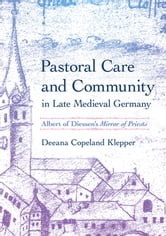
Deeana Copeland Klepper, Pastoral Care and Community in Late Medieval Germany: Albert of Diessen’s Mirror of Priests. 2022
Pastoral Care and Community in Late Medieval Germany explores how local religious culture was constructed in medieval European Christian society through close study of a set of neglected, late fourteenth-century manuscripts. The Mirror of Priests is a pastoral work written by Albert, an Augustinian canon from the Bavarian market town of Diessen, to guide local priests in their work with parishioners. Multiple versions of the text in Albert's own hand survive and, by comparing them, Deeana Copeland Klepper shows how ostensibly universal religious ideals and laws were adapted, interpreted, and repurposed by those given responsibility to implement them, thereby crafting distinctive, local expressions of Christianity.
The vision of Christian community that emerges from Albert's pastoral guide is one in which the messiness of ordinary life is evident. Albert's imagined parish was marked out by geographic and legal boundaries—property and jurisdictional rights, tithes, and sacramental responsibility—as well as symbolic realities. By situating the Mirror of Priests within Albert's physical and conceptual spaces, Klepper affirms the centrality of the parish and its community for those living under the rubric of Christianity, especially outside of large cities. Pivoting between the materiality of texts and the sociocultural contexts of an overlooked manuscript tradition, Pastoral Care and Community in Late Medieval Germany offers fresh insights into the role of parish priests, the pastoral manual genre, and late medieval religious life.

Barbara E. Mattick, Teaching in Black and White: The Sisters of St. Joseph in the American South. 2022
The Catholic University of America Press
Teaching in Black and White: The Sisters of St. Joseph in the American South discusses the work of the Sisters of St. Joseph of (the city of) St. Augustine, who came to Florida from France in 1866 to teach newly freed blacks after the Civil War, and remain to this day. It also tells the story of the Sisters of St. Joseph of Georgia, who sprang from the motherhouse in St. Augustine.
A significant part of the book is a comparison of the Sisters of St. Josephs' work against that of their major rivals, missionaries from the Protestant American Missionary Association. Using letters the Sisters wrote back to their motherhouse in France, the book provides rare glimpses into the personal and professional (pun intended) lives of these women religious in St. Augustine and other parts of Florida and Georgia, from the mid-nineteenth century through the era of anti-Catholicism in the early twentieth century South. It carries the story through 1922, the end of the pioneer years of the Sisters of St. Josephs' work in Florida, and the end of Sisters of St. Joseph of Georgia's existence as a distinct order. Through the lenses of Catholicism, Florida and Southern history, gender, and race, the book addresses the Protestant concept of domesticity and how it was reinforced in Catholic terms by women who seemingly defied the ideal. It also relates the Sisters' contributions in shaping life in the South during Reconstruction as they established elite academies and free schools, created orphanages, ministered to all during severe yellow fever epidemics, and fought the specter of anti-Catholicism as it crept across the rural regions of the country. To date, little has been written about Catholics in the South, much less the women religious who served there. This book helps to fill that gap.
Teaching in Black and White provides rare glimpses into the personal and professional lives of women religious in Florida and Georgia, from the mid-nineteenth to early twentieth-century.

Tomáš Petráček, The Bible and the Crisis of Modernism: Catholic Criticism in the Twentieth Century. 2022
University of Notre Dame Press
One of the few topics in Catholic studies that demonstrates a marked about-face in theological attitudes within the Catholic Church is the reception of the historical-critical method in biblical exegesis and its dramatic rise from outright condemnation in the late nineteenth and early twentieth centuries to its official acceptance by the 1990s. The Bible and the Crisis of Modernism tells the dramatic story of the ultimate acceptance of this modern method by the Catholic Church as it worked out the relationship between faith and reason in view of advances in the social and natural sciences. Particular attention to the contributions of Czech theologians to the field of biblical exegesis foregrounds the tensions at play in the church’s gradual recognition of the value of the historical-critical method to a better understanding of the Christian scriptures.
In this extensive study of the church’s response to the historical-critical method, Petráček broaches wider topics, such as the relationship between the Catholic Church and society in the late nineteenth and twentieth centuries, the modernization of the church in the face of a changing world, the balance between institutional authority and individual freedom of conscience, and the balance between scholarly independence and ecclesial convictions. The attitude of the Catholic Church to modern scholarly research in many ways reflects its complicated relationship to the modern world in general, as The Bible and the Crisis of Modernism shows. Scholars in biblical studies, Catholic studies, and the history of the church in the Czech Republic will find Petráček’s work an enlightening addition to their collections.
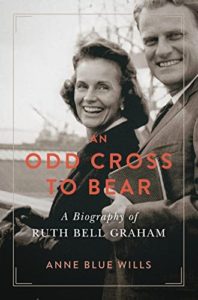
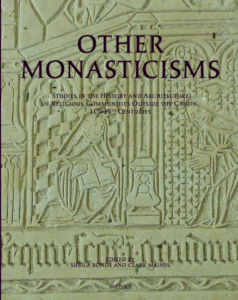
Sheila Bonde and Clark Maines, eds. Other Monasticisms: Studies in the History and Architecture of Religious Communities Outside the Canon, 11th-15th Centuries. 2022
Monasteries contributed to every aspect of life during the middle ages, from the structures monks built, to land management, craft production to the intellectual and spiritual life of the medieval world. There were more than 300 orders or congregations in existence during the middle ages, yet scholarship considers only a small number of them (notably Cistercians and Cluniacs), and privileges selected sites, such as Mont Saint-Michel, San Francesco in Assisi or Christ Church in Canterbury. This volume considers the history and architecture of other congregations that are essential to a more complete understanding of monasticism in the European middle ages: Augustinians, lesser known Benedictines, Carthusians, Celestines, Clarissans, and Tironensians in France, as well as the Camaldolese and Vallombrosans in Italy.
Finally, for staying up-to-date on the latest titles in all fields, we recommend regularly perusing New Books Network and its "New Books in Christian Studies” page. These pages are updated regularly.
